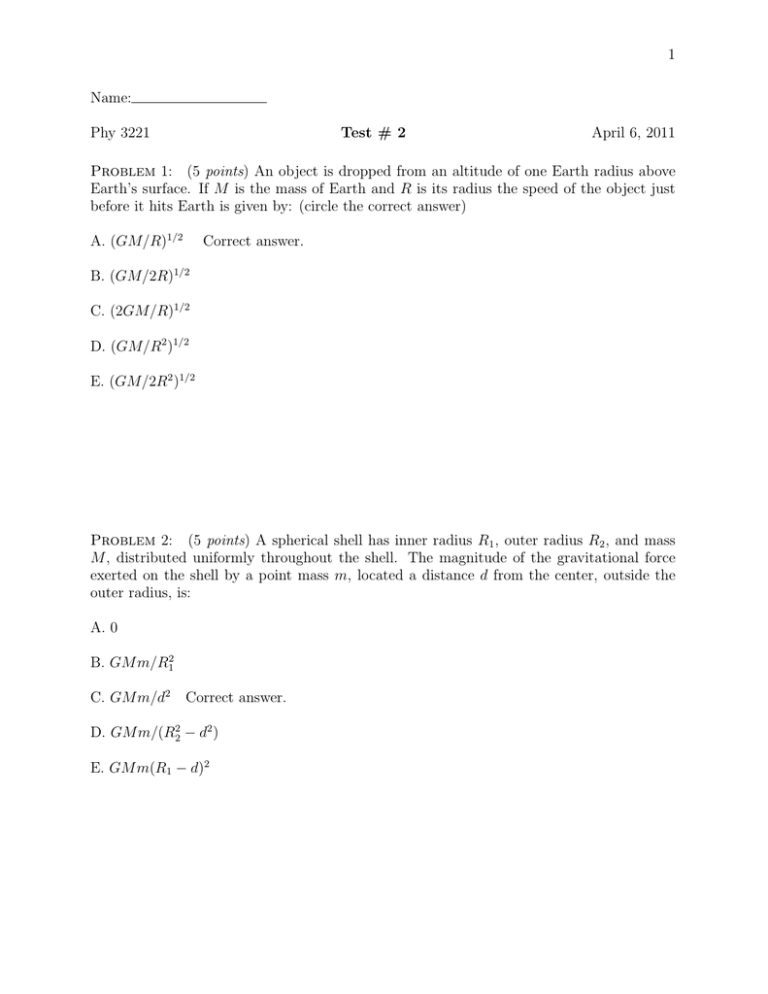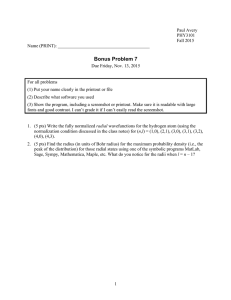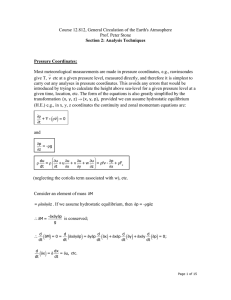1 Name: Phy 3221 Test # 2
advertisement

1 Name: Phy 3221 Test # 2 April 6, 2011 Problem 1: (5 points) An object is dropped from an altitude of one Earth radius above Earth’s surface. If M is the mass of Earth and R is its radius the speed of the object just before it hits Earth is given by: (circle the correct answer) A. (GM/R)1/2 Correct answer. B. (GM/2R)1/2 C. (2GM/R)1/2 D. (GM/R2 )1/2 E. (GM/2R2 )1/2 Problem 2: (5 points) A spherical shell has inner radius R1 , outer radius R2 , and mass M , distributed uniformly throughout the shell. The magnitude of the gravitational force exerted on the shell by a point mass m, located a distance d from the center, outside the outer radius, is: A. 0 B. GM m/R12 C. GM m/d2 Correct answer. D. GM m/(R22 − d2 ) E. GM m(R1 − d)2 2 Problem 3: An object of mass m is attracted toward the origin by a force whose magnitude is |F~ | = mk 2 /r3 . a. (5 points) If the object is in a circular orbit at radius R, then what is its speed v? mv 2 /R = mk 2 /R3 → v = k/R b. (5 points) What is the angular momentum of the object in a circular orbit at radius R? L = mvr → L = mk, independent of R. 3 Problem 4: Oort is an alien from a planet near the star Xaxes, which is 10 lt-yrs from the Earth, in our frame of reference. After a physical exam, he is diagnosed to have the dreaded Xaxian disease, flemel, and will live for only a little more than one year. Oort’s last wishes are to visit Disney World on the planet Earth and, if he has time, to abduct an Earthling. p So he gets in a Xaxian rocket and flies toward the Earth with a speed v = 0.995c, so that 1 − v 2 /c2 ≈ 0.1. In this problem it is most convenient to use units of years, and light-years. a. (3 pts.) While flying toward the Earth, what does Oort measure the distance between Xaxes and the Earth to be? p L = L0 1 − v 2 /c2 = 10 lt·yr × 0.1 = 1 lt·yr. b. (4 pts.) Approximately how many years would we measure Oort to be traveling from Xaxes to the Earth if he is traveling at nearly the speed of light? t = x/v ≈ 10 lt·yr/(1 lt·yr/yr) = 10 yr. c. (3 pts.) In Oort’s frame of reference, how long does it take Oort to reach the Earth? The proper time between take off and landing is the time measured in Oort’s frame of reference. So ∆T0 ∆T0 10 yr = ∆T = p = ⇒ ∆T0 = 1 yr. 0.1 1 − v 2 /c2 Or, from Oort’s frame of reference t = x/v ≈ 1 lt·yr/(1 lt·yr/yr) = 1 yr. 4 Problem 5: Two identical and extremely accurate clocks are synchronized on the ground. One of the clocks is put on a jet airplane which then travels in circles at 300 m/s = 10−6 c, just under the speed of sound. After a substantial time the plane returns, and the clocks are compared. The clock in the airplane differs from the one on the ground by about 1 µs = 1×10−6 s. a. (3 pt) Is the time of the clock on the ground ahead or behind the clock that was in the plane? Time dilation: Ahead p b. (1 pts) What is 1− 1 −p v 2 /c2 for the airplane? Give two significant digits. For v c p 1 2 2 2 2 2 a good approximation is 1 − v /c ≈ 1 − 2 v /c so that 1 − 1 − v /c2 ≈ 0.5×10−12 c. p (6 pts) How long the air? Show your work for partial credit. √ was the plane1 in −12 2 2 −12 1 − v /c = 1 − 10 ≈ 1 − 2 ×10 , so that p 1 1 −12 2 2 T0 = T1 / 1 − v /c ≈ T1 1 + ×10 ⇒ T0 − T1 = T1 ×10−12 2 2 Or, 10−6 s = T1 12 ×10−12 ⇒ T1 = 2×106 s, which is about one month.





